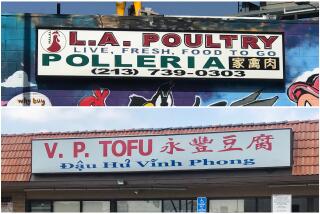On view: ‘Decades of Dissent’ shows the power of political posters
Although surpassed in popularity by social media, campaign posters continue to serve as a fundamental, democratic form of expression used by grass-roots organizers and artists to convey a message for social change.
“Decades of Dissent,” a collection of 28 silk-screen protest posters from 1960 to 1980 on view at the Skirball Cultural Center, offers a historical perspective of one of the most volatile periods of California politics illustrated through this graphic art form. Topics featured in the posters include women’s issues, gay rights, immigration reform, union empowerment and disillusionment with an unpopular war — issues that have hardly disappeared this election season.
The show, organized by the Center for the Study of Political Graphics in Los Angeles, is part of the larger “Democracy Now” initiative at Skirball, which includes “Creating the United States,” an examination of our nation’s founding documents: the Declaration of Independence and the Constitution as well as the Emancipation Proclamation.
“We want people to be able to see these posters as part of a longer history of protest that began with the Founding Fathers and continues with issues that are relevant today,” said curator Erin Curtis.
One example she noted was the “Gay In” poster promoting a solidarity event in Griffith Park. The first of three annual rallies was held on May 30, 1968. “It was a gay rights gathering that was before the Stonewall riots [in New York]. Here you have an instance of protest and resistance happening in L.A. It re-centers where we think of protests taking place.”
Familiar slogans associated with the time period such as “Make Love Not War,” and “Black Is Beautiful” are incorporated with designs of bright, bold colors, handwritten lettering and psychedelic imagery reflective of the pop art styling of the period. Works by notable artists such as Robert Rauschenberg and Sister Corita Kent are included. The majority of posters, part of a larger collection on loan from the Center for the Study of Political Graphics, were created by California artists.
Although last year’s Occupy movement created a resurgence in political graphics and poster art, Curtis says that the main difference was that in the ‘60s and ‘70s posters were the primary means of communication. “There weren’t many secondary resources available at the time. Posters could be made cheaply and distributed widely to places where more people could be reached — in the streets, in homes and on campuses.”
During the 1969 Berkeley student strike, demonstrators were using whatever they could get their hands on, such as tractor-feed paper from old dot matrix printers. “You can see tears on the corners where the posters were likely torn down from a street pole,” said Curtis. “They’re not just beautiful art pieces but also important artifacts.”
MORE:
CRITIC’S PICKS: Fall Arts Preview
TIMELINE: John Cage’s Los Angeles
More to Read
The biggest entertainment stories
Get our big stories about Hollywood, film, television, music, arts, culture and more right in your inbox as soon as they publish.
You may occasionally receive promotional content from the Los Angeles Times.










